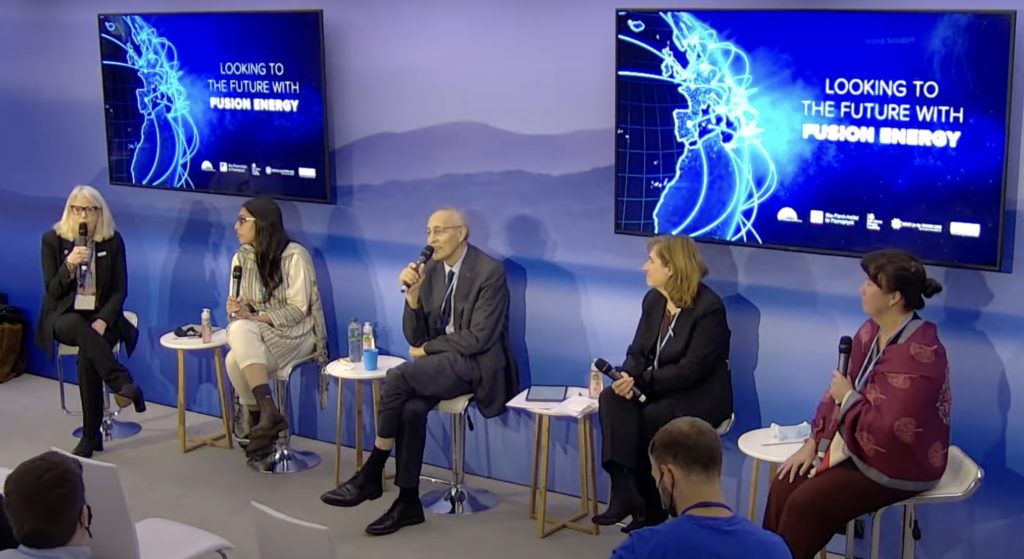ECG’s President, Jane Hotchkiss, noted that the event itself was a milestone, “We are, right now, witnessing fusion energy’s involvement in the climate discussion, and until now that’s never happened.”
For the first time, fusion was a part of the global climate discussion at the 26th UN Conference of the Parties (COP). Co-hosted by the UK Atomic Energy Authority (UKAEA) and ITER Organization, the panel conversation in the Blue Zone on the final day of COP26 was educational, compelling, instructive, and delivered a message of hope. Panelists discussed the development and commercialization of fusion energy—from the rapid advancement of technology and exciting milestones recently achieved—to the challenges ahead, including the need for public education and acceptance of fusion.
ECG’s President, Jane Hotchkiss, noted that the event itself was a milestone, “We are, right now, witnessing fusion energy’s involvement in the climate discussion, and until now that’s never happened.”
In addressing the questions of why fusion and why now, speakers focused on fusion’s promise for long-term, safe, stable, low carbon baseload to complement the expansion of renewables—a role currently filled by fossil fuels; and the collaborative private, public, and global actions that are advancing fusion to commercial viability.

Additionally, the fuel for fusion is available and plentiful in the form of isotopes of hydrogen—deuterium (D) and tritium (T). It requires only a small amount of fuel—a kilogram of D-T—to provide power to 1000 people for a year. To realize this, though, there are challenges that must be overcome; they are primarily threefold: (1) achieving temperatures that are 10x higher than in the solar interior; (2) density, having enough particles to fuse; and (3) heat insulation or energy confinement. Physicists are making significant gains—advances on an order of magnitude in the last decade—in overcoming these challenges.
A theme echoed by the panelists was that we must prepare now for the fact that those working diligently on fusion devices around the world will indeed deliver in time to make a difference. We begin by looking at the hurdles fusion will face once a device is built, including regulatory structures and finance to carry through to commercialization. Supportive government and clear policy are key to this. There is no better example than that set by ITER, the collaborative fusion experiment which has maintained the science and support of 35 nations for over 35 years, separate of military, economic, and political tensions. ITER may offer a space to develop common regulatory understanding necessary to build the global fusion economy, just as it has maintained the global scientific training, engineering, and physics talent that bring us to this important moment in our transition from fossil fuels.
We need appropriate regulation of fusion as a low hazard process, developed transparently with public input. Regulatory oversight that is transparent and more globally aligned—cooperation among nations—will build confidence, trust, and the embracing of fusion energy by all stakeholders. We need a supply chain and industry to support power plants aimed at demonstrating commercial feasibility at low cost and reasonable scale and public private partnerships to develop the supply chain and bring people together. And while significant increases of private investment in developing fusion are underway, we need more of both private and public finance.
The UK is leading by example on the public side, publishing an energy white paper that included fusion as part of a net zero program, and a fusion strategy paper that committed the UK to delivering a demonstration pilot plant that will put energy into the grid by 2040. The government has also issued proposals for the regulation of fusion and requested public input.
In the US, fusion is in a pre-commercial start-up space with enormous upside. Many of the most globally recognized tech-savvy investors are supporting 30+ private companies around the country working on fusion device builds of the varying and different technologies. Investors are following cues from recent advances in technology (materials science, supercomputing, and manufacturing) while at the same time witnessing the dire impacts of climate change.
Wind and solar cannot alone produce enough energy to offset climate change and meet global demands. As ITER’s Bernard Bigot noted, “Combatting climate change is not a competition among clean energy sources—it will require complementary effort.” Fusion is a potential disruptor to fossil. It has the capacity to supply electricity, industrial and manufacturing dense energy and heat, as well as transportation fuels from rockets to ships to terrestrial vehicles. For this reason, investors are eager to support it.
Today, scientists and engineers are hard at work advancing through fusion’s remaining technical challenges, but more is necessary if fusion is to provide all its promise for climate change mitigation. In addition to financial capital, human capital is necessary to foster informed, efficient yet comprehensive safety regulations, and those willing to invest political capital to aggressively advance the technology through the arenas of policy and law. An area where ECG is active, education of the public from elementary school students to advocacy groups, is creating a groundswell of advocates informed of the benefits, costs, and risks of fusion energy so that we beckon it to the energy mix rather than stand flat-footed when it is ready.
Fusion has the potential to change the global energy landscape. The inclusion of fusion at COP26 is an excellent step toward expanding the international dialogue in fusion development and advocacy to a global audience.
Watch the panel discussion here.
